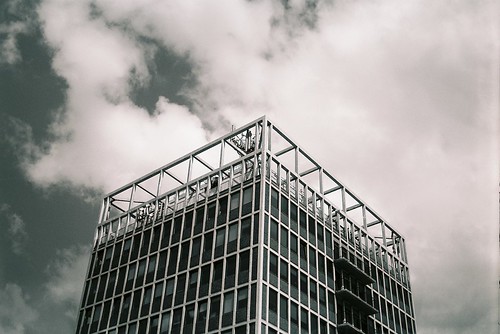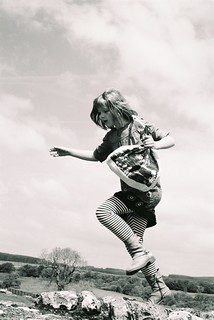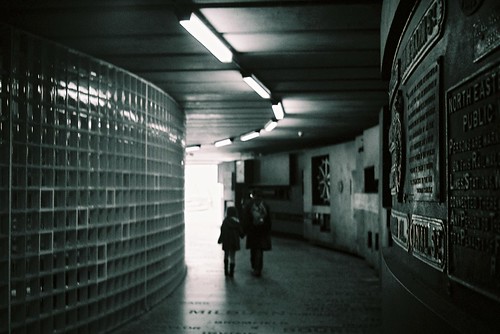
In August this Year Kodak Alaris announced the effective death of my favourite B&W film BW400CN.
This is a bit of an unusual B&W film in that it is meant to be developed in the same way that colour negative film (C41) at any photo lab. This is handy if you want to try out shooting B&W as you can have your films processed cheaply and anywhere.


There are 3 C41 films currently on the market. The others are Ilford XP2 super and Fuji Neopan 400CN (weirdly Ilford make it for Fuji – only available in Japan & UK).
All 3 films if correctly exposed have very fine grain due to their CN background although XP2 is a wee bit grainer IMHO. They do have good latitude but grain does become more evident as it does with CN when the exposure is off.
Kodak BW400CN is my favourite, very fine, next to no grain and can cope with a bit of over and under exposure. The backing plastic film sometimes adds soft subtle coffee tones to lab scanned images. Unlike the Neopan 400CN which warns of storing above 15°C it seems more tolerant with just a minor warning to protect from heat & X-rays. Contrast is good (better still with a K2 yellow filter)

They can be criticised for the lack of grain in comparison to traditional B&W and the fact that they are more expensive than some traditional B&W film (and if you self process the cost can be very cheap). The first is taste and the latter is great if (a) you have the time/space/inclination to self process or (b) are happier paying someone to do it for you (and that someone isn’t going to be your supermarket lab for a couple of quid). They are also a great bridge allowing people to dip their toes into B&W. I can shot a roll of BW400CN and get processed for £6-7 all in.

Interestingly with some tweaks you can develop BW400CN in B&W chemicals if you want (although Kodak doesn’t recommend). If C41 processed worth noting whilst great for scanning or using with C41 film paper, if you want to do darkroom stuff they don’t work easily with B&W photo paper due to the colouration of the plastic carrier material.

Kodak indicate the film will be around for at least 6 month so don’t panic. And certainly don’t fall for the chancers looking for over the odds as you can still find for around the £4-6/roll mark on ebay and even Boots still sell for about £6/roll if you buy 2 rolls on their buy one get one half price. It’s supply will likely continue for some time and in fact cost might dip as reputable sellers find stock nearing expiry date. You can still pick up expired T400CN it’s predecessor fairly cheaply so likely will be around on the expired market for some years to come
Other Info
- For the technical minded you can look at the full specs here
- Want to try developing it in B&W chemicals this flickr discussion may help

I like using the CN b/w films, and tend to use Fuji Nepoan 400CN and Ilford XP2 a lot more than the Kodak variety, mostly because I’ve managed to find larger batches of it fairly cheap! It’s worked out more cost effective with the supermarket processing I use than the far more expensive processing costs for “true” b/w film like Kodak 400TX or TMax.
What I’ve come to wonder recently though is is it still worth it at £4+ a roll, when the perfectly decent (colour) AgfaPhoto Vista Plus 200 is only £1 a roll at Poundland. Would a better option be to use the Vista Plus and convert to b/w afterwards? Is this something you have tried/ considered?
I’ve occasionally converted odd image using grayscale filters once image scanned. You can develop c41 film using b&w processing too and this make for a cheap option if you home develop (I just don’t have either time or inclination to home process). At the moment you can still pick up just expired stocks of BW400CN from the US for about £2.50 a 24 exp roll (oddly you need to buy smaller packs of either 10 or 20 as you get stung by import taxes on the bigger orders) from ebay
I’ll have to do some research on eBay, £2.50 a roll is a bargain! The cheapest you can get Ilford or Fuji is around £5, and it’s getting more expensive it seems.
I don’t develop at home – I also have neither the time or interest. Asda is my developer of choice!
I don’t know what your digital workflow/tools are, but I get very good color neg –> b+w digital by using the “channel mixers” available in Photoshop and GIMP (they appear to work identically, even though the two programs are quite different in many other respects). You can change contrast and grain dramatically (equivalent to using filters with b+w film, I suppose), by re-balancing RGB channel contributions to the monochrome result. To get a good feel for how this works, open up some color image and play around with it. I find that each source image can require different settings for optimal results; there is no ‘universal’, recommended setting.
Thanks for your thoughts and experience.
I’m not one to fiddle around in Photoshop (I never use it, I use Lightroom a little for digital work – but mostly for pictures I’ve taken of film cameras, ironically), and one of the reasons I shoot predominantly film is because it means I spend 95% of my photography time actually out with a camera as opposed to being hunched over a computer, something I do far too much of in other parts of my life!
When I’ve “converted” colour shots to b/w on the odd occasion in the past I’ve just opened them in Preview and reduced the (colour) saturation slider down to zero. The same thing happens in LightRoom, but Preview is simpler as it’s the default app for viewing photos on my MacBook.
I sometimes do this for b/w CN film too, when I don’t want the slight colour cast they give and I want a “pure” monochrome look.
You’re right about just taking some colour pics and converting them to b/w and seeing how I get on. But I need to keep it super simple, or the thought of spending too much time in post processing with film images will put me off entirely.
Ifranview is an excellent free lightweight image editor with simple choices (although has some pretty powerful features tucked under. I use it mainly to crop shots like my half frame images which come back as 2 shots an image file. It has a quick and dirty grayscale option that works well
I hear you about spending more time at the computer. OTOH I have so many 1,000s of negatives already, that I find it increasingly difficult to justify going out and shooting more. Anyhoo my go-to software for quick-and-dirty grayscale conversion (as well as assorted color adjustments, rotating, cropping, scaling, sharpening &ct) is gThumb. It works really well on some shots and for the rest is good enough to evaluate whether more heroic measures may be justified.
Curious that you evaluate whether to shoot more on how many negatives you have. I don’t really care how many I’ve already shot, the enjoyment of shooting is my main reason for photographing, especially with all the beautiful old film cameras available to us!